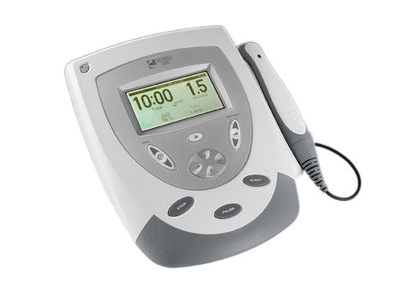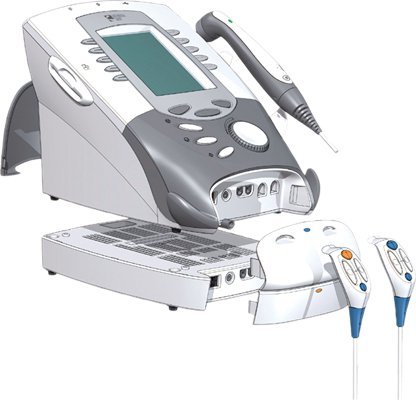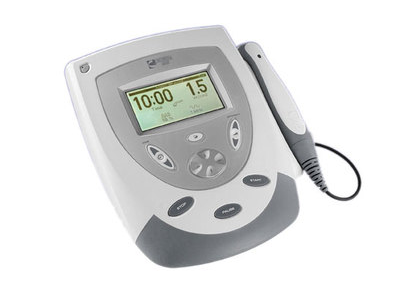 2nd Oct 2013
2nd Oct 2013
Chattanooga Ultrasound Therapy Machines
Most physical therapy practices offer ultrasound therapy because it has a proven track record for helping improve patient outcomes for a multitude of chronic conditions and injuries. We’ve explored the use of therapeutic ultrasound and its uses in a previous post. Specifically, research studies have shown therapeutic ultrasound can provide patients with the following benefits:
- Improve relaxation of tissues
- Decrease chronic pain
- Increase local blood flow and circulation
- Reduce swelling and inflammation
- Enhance breakdown of scar tissue
- Administer medications below the skin via phonophoresis. This makes it a great alternative for patients who are uncomfortable with injections
For practices looking to add ultrasound therapy to their practice may be overwhelmed with the multiple ultrasound therapy devices available on the market. Each device offers several different benefits which need to be considered when purchasing. In addition, it’s important to choose a therapeutic ultrasound device that is manufactured by a company known for stringent standards and the use of the latest innovative technology available.
Some of the best ultrasound therapy devices on the market today are made by Chattanooga. The Chattanooga brand has been around for decades. In the healthcare industry, Chattanooga is known as one of the leading innovators in manufacturing products for physical therapy, sports medicine, occupational therapy, and related medical disciplines.
One of Chattanooga’s staple products is its line of ultrasound therapy machines. Chattanooga’s current catalog features two dual-frequency machines that offer the ultrasound modality by itself. There are also several combination therapy devices in the 2013 catalog that provide ultrasound therapy along with electrical stimulation therapy.
Intelect Legend
Chattanooga’s Intelect Legend Ultrasound Machine provides two different ultrasound frequencies: 1MHz and 3.3MHz. It can be used in either pulsed or continuous modes. Some of the prominent features of the Intelect Legend ultrasound therapy system include:
Digital Signagure Interchange: Applicators use a patented technology called Digital Signature that allows the ultrasound machine to autom
atically calibrate any of the various size sound heads for the machine. This allows the user to swap out the applicators simply and easily.
Head Warming: This feature involves warming the sound head so that patients don’t experience the temperature shock that is normally felt when a cold sound head is used.
One-Two-Go Startup: The Intelect Legend is designed so that users can quickly start up the device and begin in just two steps.
Programmable Presets: The Intelect Legend allows clinicians to set customized waveform presets that are ready for use each time the machine is powered up.
Intelect TranSport
Chattanooga’s Intelect Transport adds a dimension of portability to the clinical ultrasound setup. Like the Legend model, TranSport offers dual frequency ultrasound and allows clinics to preset waveforms for quick setup. However, the Intelect Legend is lighter and comes with a handy carry bag. It is intended for therapists who need a machine that’s more mobile.
How Does Ultrasound Therapy Work?
An ultrasound treatment works by creating a thermal effect which is caused by vibration of crystals embedded in the soundhead applicator. When the soundwaves pass through the treated area, it causes a vibration of in the skin. As a result, the vibration creates a deep heating effect that will reduce pain and improve circulation. The circulation is improved because the blood vessels are opened due to the thermal effect and this allows more oxygen to be delivered to the treated area.
In addition to the thermal effect, ultrasound therapy offers other therapeutic benefits. Ultrasound therapy can help relax the tissues and breakdown scar tissue. A by-product of improved circulation is also that edema and inflammation are diminished. For patients with a bone fracture, ultrasound therapy helps promote healing.
Therapeutic ultrasound devices are versatile and can be customized to your patients need. Most therapeutic ultrasound machines come with a choice of frequencies, 1 or 3 megahertz. In addition, the soundhead applicators can be chosen based on their ability to target the treatment area. For example, a 1 cm soundhead is perfect to treat necks or elbows while a 5 cm sound head is good for treating the back. These options increase the versatility of ultrasound therapy and make it a great option for practitioners treating a variety of injuries.
What is MHz?
A megahertz (MHz) is a unit of alternating current or electromagnetic (EM) wave frequency equal to one million hertz (1,000,000 Hz). It’s important to consider which frequency to use when treating an injury or chronic condition. By choosing the correct megahertz practitioners can offer effective pain relief or accelerate healing at the site of the injury. The higher the frequency used, the less the heat penetrates the tissues, making it a great choice for areas where the bone is closer to the skin’s surface. For example, for ankle injuries, a therapist will set the frequency to 3 MHz because a higher frequency is able to effectively target the tissues needing treatment. When treating for deeper injuries such as low back pain, deeper penetration is needed, so 1 MHz is the proper frequency for this area.
In addition to the correct frequency, the choice of sound head is equally important for administering an effective treatment. To make the most of ultrasound therapy, the soundhead must have good contact with the body. So, if the sound head is too large for the treatment area, treatment won’t be administered properly. Again, consider treating an ankle at the joint which is small and rounded, if the ultrasound head is too large, it actually won’t reach most of the surface area of the ankle joint which won’t allow the ultrasound energy to disperse, meaning it will touch mostly air. This can actually cause the machine to detect no contact with the body and may cause the device to turn off.
Whether treating elbows or necks, reducing pain or accelerating healing, the versatility of ultrasound therapy is what makes it such a great tool to use in rehabilitation. Also, ultrasound therapy is non-invasive as well as time efficient. It’s a great adjunct to many physical therapy treatment plans and works well with other treatment modalities.
Some of the most common uses for ultrasound in physical therapy are:
1.Carpal Tunnel: By directing the ultrasound to the inflamed areas of the wrist, the converted sound waves create heat in the deep tissue of the hand, opening up blood vessels and delivering oxygen to the injured tissue, stimulating cell-repair. When treating carpal tunnel, ultrasound is often performed with nerve and tendon exercises in order to increase strength along with decreasing pain.
2.Migraines: Therapeutic ultrasound is useful for decreasing acute migraine pain and helping the tense muscles of the head, neck and shoulders to relax.
3.Radiating Pain: Radiating pain can be debilitating as pain can spread to surrounding areas and limit range of motion or functional movement. By improving circulation, the blood vessels are allowed to open delivering more oxygen to radiating pain areas.
4.Sciatica: Ultrasound is useful when treating sciatica particularly before stretching the piriformis muscle. The deep heating penetrates the deep soft tissue allowing the piriformis muscle to relax around the sciatic nerve, which is particularly useful during acute pain episodes.
5.Low Back Pain: While Sciatica can be localized, low back pain can be diffuse and/or radiating. With the different soundhead applicators available, ultrasound therapy is an effective treatment to pain in the area of the low back.
6.Cervical Radiculopathy: With more and more people on their laptops and phones, neck pain is on the rise. Not only is ultrasound therapy an effective treatment to improve neck pain, it also can address radiating pain and the surrounding areas. What’s more, a smaller soundhead applicator can be used to improve trigger point pain found in the neck.
7.Sprains and Strains: Characterized by immediate swelling, pain and loss of movement, it’s important to treat sprains and strains close to the time of injury. Not only is ultrasound therapy a non-invasive treatment to address these issues, but with different sized applicators, it can be used on any part of the body.
8.ACL injury: Torn ACL’s or patients who have undergone ACL repair will experience acute, sharp pain accompanied by reduced function in the knee joint. Ultrasound therapy can help immediately reduce pain while studies have found that it is also beneficial in stimulating tendon repair of the ACL.
9.Arthritis: With over 100 different types of arthritis that usually present with pain, reduced function and swelling, practitioners need a modality that can address these issues without making symptoms worse or even triggering a flare-up of other issues. Ultrasound therapy is beneficial in helping treat patients with arthritis. With the ability to choose from pulsed to continuous, 1 MHz or 3 MHz, practitioners can tailor treatment for superficial areas and the deeper tissues of the body.
10.Temporomandibular joint (TMJ) pain: Used on the jaw, the sound waves create a gentle heat that increases blood circulation to the patient’s jaw, which helps decrease pain and swelling.
Contact us today!
We can help your practice find the perfect ultrasound therapy device to work with your patient populations. Contact us today and we’ll answer any questions you may have about the benefits of each Chattanooga ultrasound therapy device! Call us today at 1-801-770-3328 for more information.








